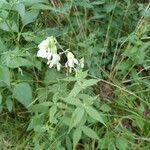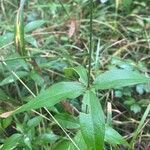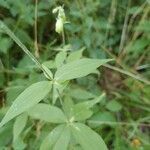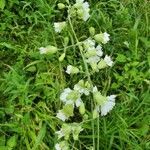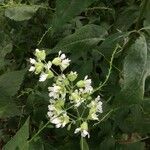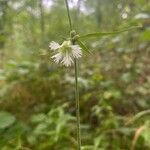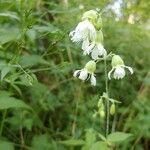Plants perennial; taproot thick; caudex branched. Stems several, simple proximal to inflorescence, 30-80 cm, puberulent, becoming subglabrous near base. Leaves withering proximally, in whorls of 4, ± sessile to short-petiolate, largest in mid-stem region; blade lanceolate to ovate-lanceolate, 3-10 cm × 4-40 mm, apex acuminate, puberulent on both surfaces, sparsely so adaxially. Inflorescences paniculate, open, bracteate, bracteolate, branches elongate, puberulent; bracts and bracteoles linear-lanceolate, 2-15 mm. Pedicels straight, often with 1 or 2 pairs of bracteoles, slender, 1/ 2-3 times calyx, glabrous or scabrous-puberulous. Flowers: calyx obscurely 10-veined, broadly campanulate, becoming obtriangular in fruit, 7-11 × 6-10 mm, herbaceous, margins dentate, very narrow, membranous, sparsely puberulent, lobes broadly triangular, 2-3 mm; corolla white, ca. 2 times longer than calyx, limb obtriangular, narrowed into claw, divided ca. 1/ 2 its length into 4-12 lobes, appendages absent; stamens equaling petals; styles 3, longer than petals. Capsules globose, opening by 3 broadly triangular teeth; carpophore 2-3 mm. Seeds dark brown, reniform, ca. 1 mm, papillate. 2n = (34), 48.
More
Perennial with several simple, puberulent stems 3–12 dm; cauline lvs mostly in whorls of 4, lance-linear to lance-ovate, 3–10 cm, to 4 cm wide, acuminate; infl loosely paniculate; cal campanulate, 5–12 mm, finely puberulent; pet white, 8–11 mm, lanate at base, the auricles and appendages none, the blade fimbriately 8–12-lobed; carpophore 2-3 mm; styles 3; capsule dehiscent by 6 teeth; 2n=48. Woods. June–Aug. Var. stellata, with essentially glabrous pedicels and cal, occurs from Conn. to O. and Nebr., s. to Ga. and Tex. Var. scabrella (Nieuwl.) E. J. Palmer & Steyerm., with densely crisp-puberulent pedicels and cal, occurs from O. and Mich. to N.D., s. to Tenn. and Tex.
Rich deciduous woods, river flats, tall-grass prairies; at elevations up to 1,300 metres.
